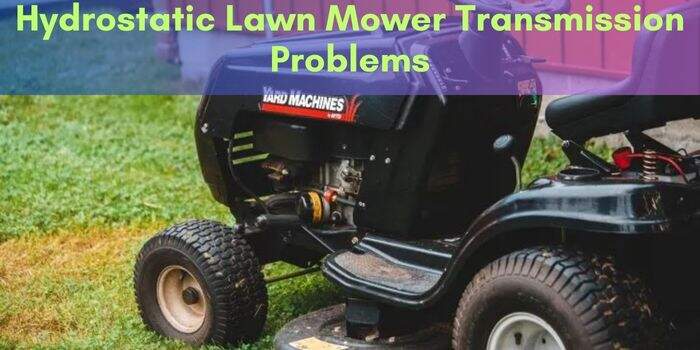Hydrostatic Lawn Mower Transmission Problems: Fix Your Issues Fast
Hydrostatic lawn mower transmission problems can be fixed quickly by troubleshooting common issues such as drive belt checks, drive pulley failure, and changing transmission oil. Grinding gears, inconsistent operation, and wheels not rotating with the pulley are signs of a faulty transmission.
Regular maintenance and prompt action at the first sign of trouble can extend the lifespan of the transmission.
Hydrostatic lawn mower transmissions, while offering smooth and efficient performance, can face a variety of issues that affect their functionality and longevity. Understanding these problems and knowing how to address them can help maintain your mower in optimal condition.
Common Hydrostatic Transmission Problems
1. Transmission Fluid Issues
Fluid Contamination: Dirt, debris, and water can contaminate the transmission fluid, leading to reduced lubrication and increased wear. Ensure you use the correct type of fluid as specified by the manufacturer.
Low Fluid Levels: Insufficient fluid levels can cause the transmission to overheat and fail. Regularly check fluid levels and top up as necessary.
Fluid Degradation: Over time, transmission fluid can degrade, losing its effectiveness. Replace fluid according to the maintenance schedule to ensure peak performance.
2. Overheating
Hydrostatic transmissions can overheat if used extensively without adequate cooling. Overheating can lead to reduced efficiency and potential damage.
Ensure the cooling fans and vents are clean and unobstructed. If overheating persists, consider using an external cooling system or heat sink.
3. Mechanical Failures
Worn Seals and Gaskets: These components can wear out over time, leading to fluid leaks. Regular inspection and replacement of seals and gaskets are crucial.
Damaged Pumps and Motors: The hydraulic pump and motor can wear out, causing performance issues. Symptoms include sluggish movement and reduced power. Regular maintenance can help detect and prevent these issues early.
Valve and Cylinder Wear: Valves and cylinders within the transmission can wear, leading to reduced efficiency and potential failure. Ensure these parts are inspected regularly and replaced if necessary.
4. Air in the System
Air trapped in the hydraulic system can cause erratic operation and reduce transmission efficiency. Bleeding the system to remove air can restore normal operation. Follow the manufacturer’s guidelines for the correct bleeding procedure.
5. Control Linkage Problems
The linkage connecting the control lever to the transmission can become loose or misaligned, leading to control issues. Regularly inspect and adjust the linkage to ensure smooth operation.
Troubleshooting Hydrostatic Transmission Issues
Having trouble with your hydrostatic lawn mower transmission? Don’t worry, we’ve got you covered. Learn how to troubleshoot and fix common hydrostatic transmission issues quickly and easily.
Discover the secrets to keeping your lawn mower running smoothly all season long.
Checking The Drive Belt For Wear And Tear:
- Inspect the drive belt for signs of wear, such as cracks or fraying.
- Ensure that the belt is properly tensioned and aligned.
- Check for any debris or obstructions that may be affecting the belt’s performance.
- Replace the drive belt if necessary to restore smooth operation.
Identifying Drive Pulley Failure Signs:
- Look for signs of damage or wear on the drive pulley, such as cracks or excessive play.
- Listen for any unusual noises coming from the drive pulley area.
- Check for leaks or fluid dripping from the pulley.
- If the drive pulley shows any signs of failure, it may need to be replaced or repaired.
Importance Of Changing Transmission Oil Regularly:
- Regularly changing the transmission oil is vital to keep the hydrostatic transmission running smoothly.
- Over time, the transmission oil can become contaminated with dirt, debris, and moisture, which can degrade its performance.
- Changing the transmission oil at recommended intervals helps to maintain optimal lubrication and cooling for the transmission.
- Be sure to use the manufacturer’s recommended type and grade of transmission oil for best results.
Maintaining Proper Fluid Level And Quality:
- Check the fluid level regularly to ensure it is within the recommended range.
- If the fluid level is low, top it up with the appropriate transmission oil.
- Monitor the fluid quality for any signs of contamination or degradation.
- If the fluid appears dirty or has a burnt smell, it may be necessary to drain and replace it with fresh oil.
Avoiding Excessive Loads And Harsh Operating Conditions:
- Hydrostatic transmissions are designed for regular, everyday use.
- Avoid putting excessive loads on the transmission, such as towing heavy objects beyond the recommended capacity.
- Avoid operating the lawn mower in extreme conditions, such as excessively steep slopes or deep mud.
- Operating within the recommended limits helps to prevent excessive wear and prolong the lifespan of the hydrostatic transmission.
Regularly Inspecting And Maintaining The Cooling System:
- Hydrostatic transmissions generate heat during operation, and a properly functioning cooling system is essential to dissipate this heat.
- Inspect the cooling fins and ensure they are clean and free from any debris or obstructions.
- Check that the cooling fan is operating correctly and replace it if necessary.
- Clean or replace the transmission cooler if it becomes clogged or damaged.
Lubricating The Linkage And Pivot Points:
- Proper lubrication of the linkage and pivot points ensures smooth and efficient operation of the hydrostatic transmission.
- Use a suitable lubricant, such as a multipurpose grease, to lubricate these components.
- Regularly inspect and lubricate the linkage and pivot points according to the manufacturer’s recommendations.
Checking For Air In The System:
- Air in the hydrostatic transmission system can cause erratic operation and performance issues.
- Bleed the system to remove any trapped air if necessary.
- Follow the manufacturer’s instructions to properly bleed the system and restore optimal function.
Seeking Professional Assistance When Needed:
- If troubleshooting and maintenance efforts do not resolve the hydrostatic transmission problems, it may be necessary to seek professional assistance.
- Certified technicians have the knowledge and expertise to diagnose and repair complex issues.
- Contact a reputable service center or the manufacturer’s customer support for further assistance.
Diy Fixes For Hydrostatic Transmission Problems
Fixing hydrostatic transmission problems on your lawn mower is easier than you think. Learn how to troubleshoot and solve issues like slipping, changing transmission oil, and inspecting gears with simple DIY fixes. Keep your mower running smoothly with these tips.
Hydrostatic lawn mower transmission problems can be frustrating, but luckily there are some DIY fixes that you can try before calling in a professional.
Below is a step-by-step guide to help you troubleshoot and resolve common issues with your hydrostatic transmission.
Step-By-Step Guide For Draining The Transmission Oil:
- Begin by locating the drain plug on the transmission. It is usually located on the bottom and may require a wrench to loosen.
- Place a drain pan underneath the plug to catch the old oil as it drains out.
- Slowly loosen the plug, allowing the oil to drain completely.
- Once the oil has drained, securely tighten the drain plug back into place.
Inspecting And Troubleshooting The Transmission:
- Check the transmission belt for any signs of wear or damage. If the belt is worn or frayed, it may need to be replaced.
- Inspect the transmission pulley for any debris or build-up that could be interfering with its movement.
- Check the transmission fluid level. If it is low, refill it with the recommended fluid for your mower.
- Test the mower to see if the transmission is functioning properly. If not, further troubleshooting may be required.
Installing New Gears And Cleaning Magnets:
- If you suspect that the gears in your transmission are worn or damaged, they may need to be replaced. Consult your mower’s manual for instructions on how to remove and install new gears.
- If your mower has magnets inside the transmission, remove and clean them to ensure that they are functioning properly. Magnets can collect metal shavings and debris over time, which can interfere with the transmission’s performance.
Applying Gasket Maker And Refilling With Oil:
- If you have replaced any gaskets or seals in the transmission, apply gasket maker to create a secure seal and prevent leaks.
- Refill the transmission with the recommended oil. Be sure to use the correct type and amount as specified in your mower’s manual.
Properly Reinstalling The Transmission Belt:
- Carefully reattach the transmission belt, making sure it is properly aligned and tensioned.
- Double-check that the belt is routed correctly around all pulleys and that it is not twisted or kinked.
- Test the mower to ensure that the transmission belt is working smoothly and that the mower is moving correctly.
How Does A Hydrostatic Transmission Work?
A hydrostatic transmission uses fluid to transfer power from the engine to the wheels, allowing for smooth and seamless operation. Here’s a breakdown of how it works:
- A hydraulic pump converts the mechanical energy from the engine into hydraulic pressure.
- The hydraulic pressure is then used to drive a hydraulic motor, which turns the wheels.
- The fluid inside the transmission plays a vital role in controlling the speed and direction of the mower.
The Role Of The One-Speed Pump
The one-speed pump in a hydrostatic transmission is responsible for generating hydraulic pressure. Here’s how it functions:
- The pump consists of a swash plate that can be tilted to increase or decrease the flow of fluid.
- When the swash plate tilts, it changes the displacement of the pump, resulting in a higher or lower flow rate.
- By adjusting the flow rate, the one-speed pump controls the speed of the hydraulic motor, and consequently, the speed of the lawn mower.
Explaining The Variable Swash Plate
The variable swash plate is a key component of the hydrostatic transmission. Here’s what you need to know about it:
- The swash plate is connected to the control lever on the mower.
- By adjusting the position of the control lever, you can tilt the swash plate and modify the fluid flow.
- Increasing the tilt angle of the swash plate increases the flow of fluid, leading to higher mower speed.
- Decreasing the tilt angle reduces the fluid flow, resulting in slower speed or even reverse motion.
Understanding these components of a hydrostatic transmission will help you identify and troubleshoot any issues that may arise. Stay tuned for our next section, where we’ll explore common hydrostatic mower transmission problems and their possible solutions.
Frequently Asked Questions
What Is A Common Problem With Hydrostatic Transmission?
A common problem with hydrostatic transmission is temperature control, pre-charging, and over-pressure protection. Correct maintenance and prompt action are necessary for long-lasting performance.
How Do I Know If My Lawn Mower Transmission Is Bad?
Grinding gears, starting and stopping during operation, and wheels not rotating with the pulley are signs of a bad lawn mower transmission.
How Many Hours Should A Hydrostatic Transmission Last?
A hydrostatic transmission typically lasts for 1,000 to 2,000 hours of use.
Do Hydrostatic Transmissions Need Maintenance?
Hydrostatic transmissions require maintenance for long life. Common signs of transmission problems include grinding gears and wheels not rotating with the pulley.
Conclusion
Hydrostatic lawn mower transmission problems can be frustrating, but with the right knowledge and troubleshooting techniques, they can be resolved. From understanding how a hydrostatic transmission works to checking the drive belt and changing the transmission oil, there are steps you can take to fix the issue.
Draining the transmission oil and inspecting the transmission for any damage or worn-out gears are essential tasks.
Applying gasket maker and filling the transmission with oil are also important steps to ensure proper functioning. Additionally, knowing where to put transmission fluid and whether it’s worth flushing the transmission are key considerations.


